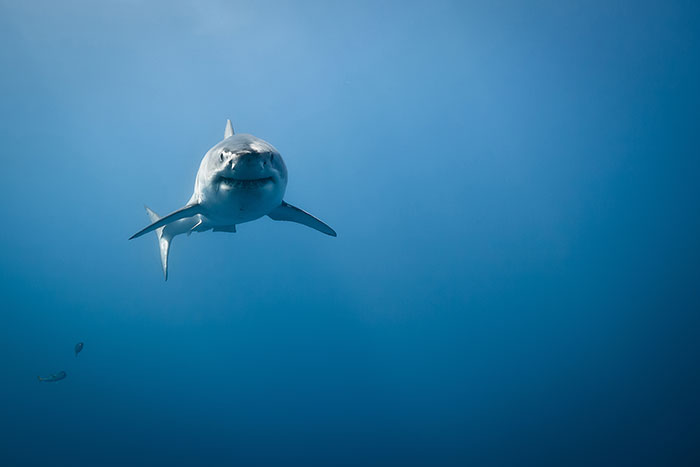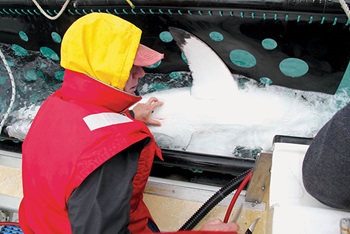A scientific technique developed in Australia to estimate Southern Bluefin Tuna stocks is being applied to other species
 Photo: 123rf.com
Photo: 123rf.comBy Bianca Nogrady
To work out the size and demographics of a human population we have endless tools at our disposal: a census, electoral rolls, surveys, polls and electronic health records, to name a few.
When it comes to doing the same for sharks things get a little tricky. They are a highly mobile population with poorly understood geographic distribution that could span hundreds of thousands of kilometres, the adults and juveniles occupy different spaces in the ocean and they are terrible at filling out forms.
But, thanks to CSIRO research funded by the FRDC, scientists now have a tool that can be used to not only estimate the size of shark populations, but could also be applied to a whole range of marine species.
Close-kin mark-recapture was first used to estimate the size of the Southern Bluefin Tuna population. The idea is deceptively simple: if you have two samples from a population, the likelihood of those two individuals being related to each other – either a parent to their offspring, or two siblings or half-siblings – decreases with increasing population size.
The genetic pool
For example, if you take a genetic sample from two individuals in Sydney, the chance of them being related to one another is a lot smaller than if you took genetic samples from two individuals living in a small town.
“The basic principle is every fish or every mammal or every bird only has two parents, and that is what sets up this natural mark-recapture experiment,” says Campbell Davies, a senior principal research scientist at CSIRO Marine and Atmospheric Research.
So if samples are taken from a large enough number of individuals, the number of parent–offspring or half-sibling pairs in that sample set can enable researchers to work out the size of the entire adult population.
“The juveniles are tagging their parents through their DNA,” Campbell Davies says. “That’s the magic bit: it doesn’t require you to see or sample the adults – you’re getting that information through the relationship of their offspring.”
This approach was first considered for Southern Bluefin Tuna because of concerns over the accuracy and reliability of fisheries estimates, and because of the difficulty and expense associated with conducting a conventional scientific survey of the species.
Great White Sharks
 Right Russ Bradford testing and tagging a Great White Shark.
Right Russ Bradford testing and tagging a Great White Shark.Photo: Kent Stannard
Even less is known about Great White Sharks. Despite being listed as ‘vulnerable’ on the International Union for Conservation of Nature and Natural Resources’s ‘Red List’, their numbers are uncertain, and what little information is available largely comes from shark-control programs. It is also difficult to find adult Great White Sharks.
Thankfully, juvenile Great Whites are a little more accessible than their parents, so while researchers could not use the parent–offspring relationship to work out population size, they could still look for half-siblings.
“The same principle applies – that the more parents there are, the less likely you are to find a half-brother or sister, so you can flip that to find how many adults there are,” says Rich Hillary, principal research scientist at CSIRO Oceans and Atmosphere.
With that in mind, researchers began collecting genetic samples from juvenile Great White Sharks off the eastern and southern coasts of Australia.
In the first phase of the study, they collected samples from 214 juvenile Great Whites, including 73 half-siblings. Using modelling developed by CSIRO statistician Mark Bravington, they were able to estimate the size of the Australasian adult Great White population at about 2250 individuals.
It also confirmed that there are two distinct populations of Great Whites off the Australian coast: an eastern Great White population consisting of about 750 individuals, and a larger western population of about 1500 Great Whites.
“If you draw a line from Wilsons Promontory in Victoria down to the top of Tasmania, everything to the east of there is one population – and that includes New Zealand – and everything to the west of there we call the southern–western population,” Rich Hillary says.
These numbers, and additional data from stored samples from juvenile Great White sharks, suggest that the Great White population has remained at around the same size for the past decade. But Rich Hillary says it is very possible that the number of adults may start to increase as the protections that have been in place since the late 1990s mean more juveniles should survive to adulthood.
Shark sampling
Obtaining samples from the Great Whites certainly is not easy. In the Southern Bluefin Tuna studies, the genetic samples could be collected from catches, so researchers were able to collect genetic information for about 17,000 fish. But even finding Great Whites can be a challenge. However, juvenile Great Whites are known to gather every summer on the NSW coast near Port Stephens, which makes it an ideal location to gather samples.
To get the genetic samples from the Great Whites, the sharks have to be professionally caught, sampled, tagged and released – all without causing any long-term harm to the fish.
“It’s pretty hard to get through the skin of a shark, especially a Great White Shark, because it’s very thick,” Rich Hillary says. So the juveniles are caught, tired out, then brought to the side of the boat and flipped on their back, which has a sedative effect on the shark. Scientists can also work with samples taken from dead sharks that have washed up on shore, or been killed or caught in nets.
The technique has proven so successful that it is now being applied in more shark species, in particular the School Shark in an FRDC-funded project, the Speartooth Shark and the Greynurse Shark.
Other species
The School Shark, which is being researched by Robin Thomson at CSIRO, is a commercially valuable species that became overfished as a consequence of Australians’ love of fish and chips. The fishery was closed in the mid-2000s to allow it to rebuild, and now the close-kin mark-recapture technique is being used to estimate the size of the fishery.
The Speartooth Shark is a critically endangered river shark found in the north of Australia, whose adults are notoriously elusive.
“The juveniles live in the river, so the half-sibling approach is really useful there,” Campbell Davies says.
Similarly, the Greynurse Shark is another critically endangered species (on the east coast, the Western Australian population is listed as vulnerable) that researchers have been targeting with the close-kin mark-recapture approach.
In theory, the technique can be used for any marine creature, such as whales or turtles, Rich Hillary says, although there are some notable exceptions.
“Elephant seals wouldn’t work because you get one dominant beach male, and he’s always going to show up as the dad everywhere, so it’s going to be a very biased sample,” he says. “When you’ve got really strong selection towards a dominant male or female, that tends to make a bit of a mess of everything because they just keep showing up everywhere.”
The technique is also being applied in other tuna species. Work is underway to develop models applying it to Atlantic Bluefin Tuna and Pacific Bluefin Tuna stocks, with the US, Taiwan and Japan all expressing interested in using the method.
“The fact it works for such a broad range of species is both encouraging and exciting because it’s not just going to be a case of something that would be useful for tuna,” Campbell Davies says. “We have been surprised by how well that has worked. It is without a doubt one of the most exciting bits of science that I’ve been involved with in my career.”
FRDC Research Codes: 2007-034, 2014-024
More information
Rich Hillary, rich.hillary@csiro.au





